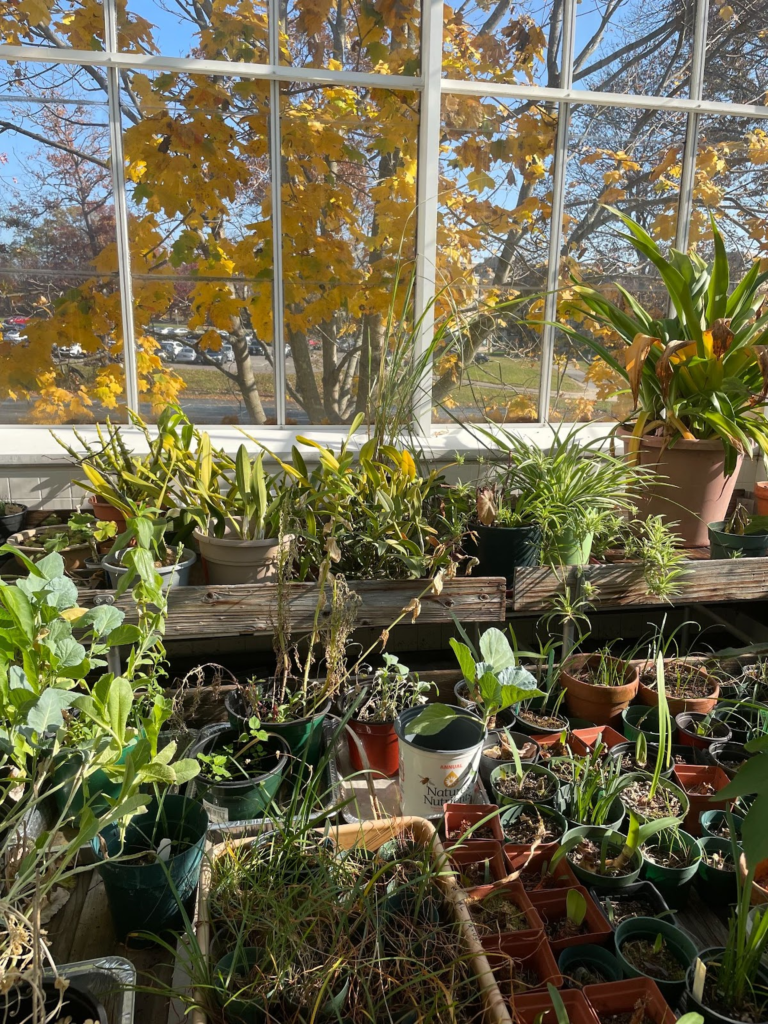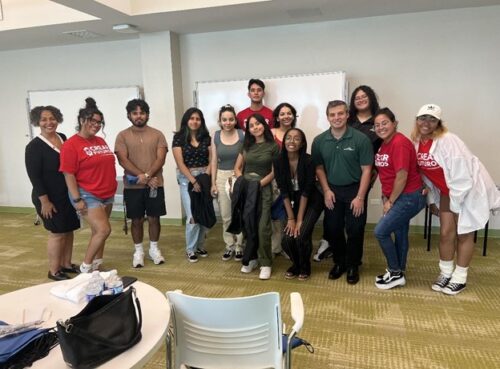
Situated all the way in the back of the Natural Sciences Building (NSB) is a small greenhouse that is home to a wide variety of foliage and vegetation. The greenhouse was created alongside the Natural Sciences Building (NSB) in 1985. The space is run by Nikki Rodgers, a volunteer greenhouse coordinator. Rodgers not only takes care of the space, but she also prepares chemicals for students to use for their laboratories and for professors to use for their studies and teachings.
The space is open to everyone to join or relax in. It is also used for science classes, where biology students can utilize the space to grow different vegetation and learn and understand how plants develop. The greenhouse used to be taken care of by Dr. Anthony DeLuca, who was previously a professor of the Honors College. In January of 2022, in light of the COVID-19 pandemic, Dr. DeLuca retired. In that time frame, a lot of the plants were moved out of the greenhouse. When Dr. DeLuca was in charge of the greenhouse, he used to take students on field trips to do volunteer planting at plots.
When students and faculty came back to school from the pandemic, Rodgers described the greenhouse as “barren.” So, she decided to take it upon herself to take the empty greenhouse back to what it was prior to the pandemic. Rodgers connected with staff and faculty on campus and with plant nurseries who were interested in getting involved.
The vegetation in the greenhouse includes monstera deliciosa (swiss cheese plant), a variety of mosses and ferns, little succulents, and cacti. The greenhouse also has a secondary unit which is a larger room that features a mixed variety of plants, including medicinal herbs like chamomile, and edible plants like different types of basil and tomatoes. Rodgers said in the future, she hopes to donate these edible yields to the Panther Food Pantry or just hand them out to professors or students who may want them.
Amongst tending to the greenhouse, Rodgers is also a part of the Green Committee on campus. The committee is open for students and faculty alike to join. The group partakes in talks every other month about how the campus isn’t doing enough to create a sustainable campus. Rodgers has a master’s degree in energy policy and climate from John Hopkins University, where she wrote her thesis on sustainability and building efficiency, specifically for the NSB.
Rodgers said she looked at other SUNY schools to compare what they’re doing to create a more sustainable campus to SUNY Old Westbury. Rodgers deduced that “we’re not doing nearly enough.” She explained that she doesn’t want to lecture students about recycling every single plastic they own or switching to using tote bags instead of plastic bags–she wants to teach them that practicing sustainability doesn’t have to be so strict.
“There are a couple of things that not just the campus should do, but an individual can do. Sustainability can mean many, many different things. It depends on the accessibility of a person,” Rodgers said. On campus, Rodgers expressed how she would love to see more sustainability on campus through a change of mindset on what the school should be doing and funding. The greenhouse is currently not funded by the university. Everything is funded by Rodgers or from what other faculty or staff can provide, including gifting plants or bringing in their plants to house for the winter. So, what Rodgers would like to see is the “funding of seasonal projects on campus,” which to her is most important before beginning anything else. Rodgers said that her goal with the greenhouse is to provide a space that showcases sustainability and allows people to talk about it.
Melia Mirdha, a member of the Environmental, Sustainability, and Melittology Club (ESM), said that the club collaborates with the greenhouse sometimes, especially when holding events. Mirdha explained, “We basically ask her [Rodgers] if we’ll be able to use the greenhouse for the event.” At their last event, the club taught students how to sow plants and they provided a demo on how to plant succulents in the greenhouse. Students relaxed before their upcoming exams, drank tea, and ate cookies. The ESM club’s goal is to promote sustainability and make sure everyone on campus is aware of environmental issues including pollution and fast fashion.
Dr. Jessica Curran, the faculty advisor of the ESM club, said she “doesn’t work a ton with Nikki,” but shares similar goals with her. Curran mostly teaches English courses, but she also teaches courses that incorporate English with environmentalism and sustainability, including an environmental literature course she teaches at SUNY Old Westbury in the spring. Between the NSB and the Clark Athletic Center on campus, there’s a community garden with plants that are maintained by the Honors College. There, students planted a garden where they harvested onions, carrots, and potatoes that they gave to the Panther Food Pantry. Curran said gardening is a “labor of love.” She expressed that she wanted to highlight to students the importance of farmers.
Curran’s personal website features a document titled, “Declaration of Interbeing,” written by Kinari Webb, Guardians of the Trees. The document is a declaration to work toward a more healthy and sustainable planet: “I hereby declare my intention to work toward a healthier and more sustainable relationship to the planet on a personal, community, and global level. I will become a force for healing and change in the face of the greed, injustice, and destruction that threaten the viability of the earth for sustaining human life, as well as all other life…”







